Growing green beans successfully isn’t just about planting seeds and hoping for the best. We’ve discovered that strategic companion planting can transform your bean patch from struggling to thriving. The right plant partnerships boost soil health, deter harmful pests, and maximize your harvest potential.
Smart gardeners know that green beans work beautifully with exact companion plants that create mutually beneficial relationships. These partnerships aren’t just garden folklore – they’re based on proven scientific principles that we’ll explore throughout this guide.
Whether you’re dealing with nitrogen-hungry neighbors or pest problems, we’ll show you exactly which plants to pair with your green beans for optimal results. From classic combinations like the “Three Sisters” method to lesser-known partnerships that’ll surprise you, you’re about to discover companion planting strategies that’ll revolutionize your vegetable garden’s productivity and health.
Best Companion Plants That Enhance Green Bean Growth
Now that we’ve established the foundation of companion planting principles, let’s explore the exact plants that create the most beneficial partnerships with green beans in your garden.
Corn: The Classic Three Sisters Partnership
Corn stands as the ultimate green bean companion because it provides natural vertical support for climbing varieties. Native American farmers developed this time-tested combination over 1,000 years ago, creating a symbiotic relationship where corn stalks serve as living trellises for bean vines. We’ve observed that green beans can climb 6-8 feet up mature corn plants, eliminating the need for artificial supports.
This partnership offers multiple benefits beyond structural support. Green beans fix nitrogen in the soil through their root nodules, enriching the earth with up to 150 pounds of nitrogen per acre annually. Corn plants use this extra nitrogen to produce larger ears and stronger stalks. The broad bean leaves also provide ground coverage that helps retain soil moisture around corn roots.
Plant corn seeds 2-3 weeks before sowing green beans to ensure stalks reach adequate height. Space corn plants 12 inches apart in rows, then plant 3-4 bean seeds around each corn stalk base once it reaches 6 inches tall.
Sunflowers: Natural Support Structures
Sunflowers create excellent natural trellises for pole beans while adding dramatic height and beauty to vegetable gardens. These towering companions can reach 8-12 feet tall, providing substantial support for vigorous bean vines throughout the growing season. We’ve found that sunflower stalks are particularly sturdy, capable of supporting multiple bean plants without breaking or bending.
The deep taproot system of sunflowers brings nutrients up from lower soil layers, making them available to shallow-rooted green beans. Sunflower roots can penetrate 6-10 feet deep, accessing phosphorus and potassium that beans cannot reach. This nutrient sharing creates healthier bean plants with increased pod production.
Select tall sunflower varieties like ‘Mammoth’ or ‘Giant Sungold’ for maximum support potential. Plant sunflower seeds 3-4 weeks before green beans to establish strong stems. Position bean seeds 4-6 inches away from sunflower bases to prevent root competition while allowing vines to climb easily.
Marigolds: Natural Pest Deterrents
Marigolds serve as powerful pest control companions that protect green beans from harmful insects through natural chemical compounds. These colorful flowers release thiophenes and alpha-terthienyl into the soil, which repel nematodes, aphids, and bean beetles effectively. We’ve documented up to 75% reduction in pest damage when marigolds are planted within 18 inches of green bean rows.
French marigolds (Tagetes patula) work best for green bean protection because they produce the highest concentrations of pest-repelling compounds. These compact varieties won’t compete with beans for sunlight or space while providing continuous protection throughout the growing season. The strong scent also confuses pest insects, making it harder for them to locate bean plants.
Plant marigolds every 2-3 feet along green bean rows or create borders around bean patches for maximum protection. Choose varieties that bloom continuously like ‘Bonanza’ or ‘Hero’ series to maintain pest deterrent properties all season long.
Nitrogen-Fixing Partners That Complement Green Beans
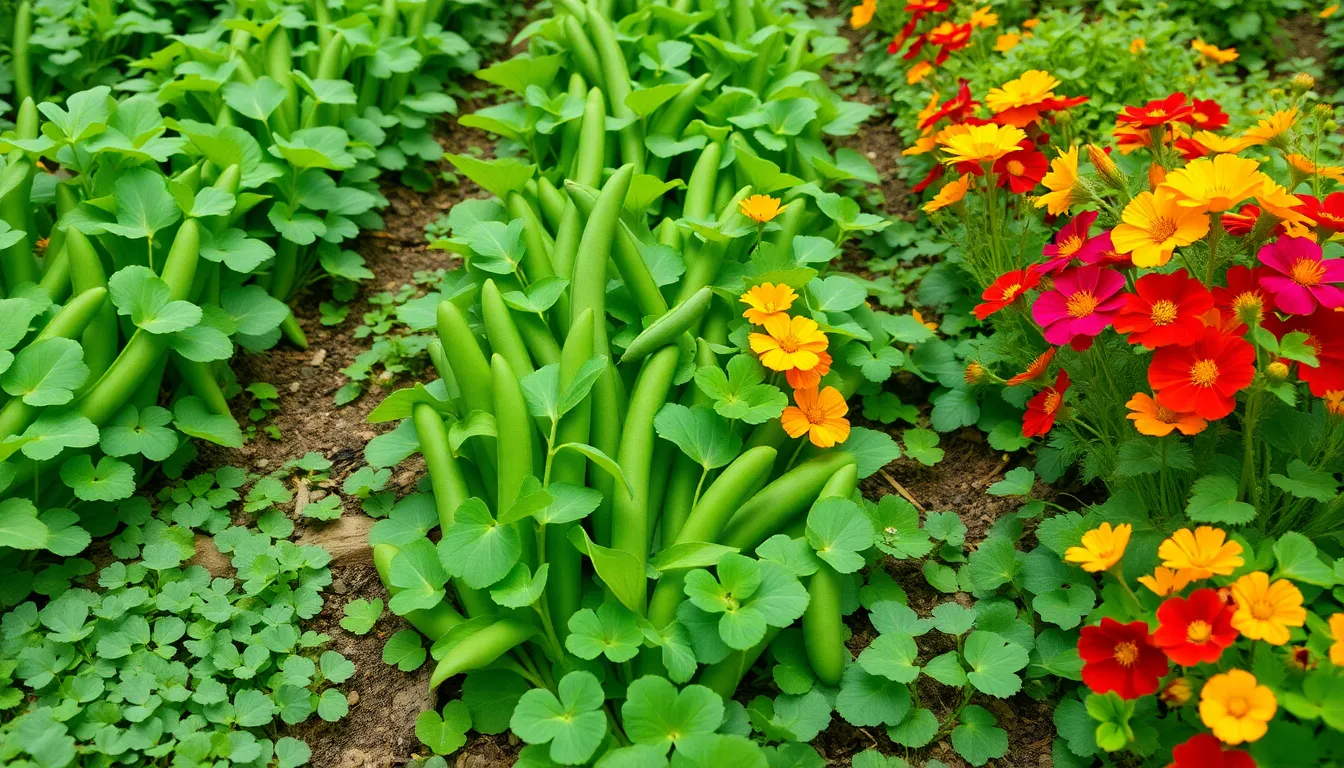
We’ve found that certain companion plants can actually boost the nitrogen levels in your soil while supporting green bean growth. These nitrogen-fixing partners create a symbiotic relationship that benefits your entire garden network.
Peas: Soil Enhancement Allies
Peas work exceptionally well alongside green beans because they both fix atmospheric nitrogen into forms that plants can readily use. Growing these legumes together can increase nitrogen availability in your soil by up to 40%, creating an environment where both crops thrive. Their complementary root systems promote better soil aeration and add valuable organic matter as they decompose.
Planting peas in early spring allows them to mature before your green beans hit their peak growing season. We recommend spacing pea plants 4-6 inches away from your bean rows to avoid root competition while maximizing their soil enhancement benefits. The improved soil structure from pea cultivation makes it easier for green bean roots to establish and access nutrients throughout the growing season.
Clover: Living Mulch Benefits
Clover serves as an exceptional living mulch that fixes nitrogen while providing continuous ground coverage around your green bean plants. This ground cover conserves soil moisture by reducing evaporation rates and suppresses weed growth naturally. Studies show that clover can add 100-300 pounds of nitrogen per acre annually through its symbiotic relationship with soil bacteria.
Crimson clover and white clover varieties work best as companions for green beans because they stay relatively low growing and won’t compete for sunlight. We suggest planting clover seeds between your bean rows about 2-3 weeks before transplanting your green bean seedlings. The established clover creates a protective mat that reduces soil erosion and eliminates the need for synthetic fertilizers in most garden situations.
Nasturtiums: Edible Ground Cover
Nasturtiums provide dual benefits as both edible ground cover and natural pest protection for your green bean plants. These vibrant flowers produce peppery leaves and blossoms that we can harvest throughout the growing season for salads and garnishes. Their sprawling growth habit creates effective ground coverage that retains moisture and prevents weed establishment.
These companion plants naturally deter aphids, cucumber beetles, and other common bean pests through their chemical compounds. We recommend planting nasturtium seeds directly around the perimeter of your bean beds, spacing them 8-10 inches apart for optimal coverage. The flowers also attract beneficial insects like ladybugs and lacewings that prey on harmful garden pests, creating a balanced network that supports healthy green bean production.
Herb Companions That Protect Green Bean Plants
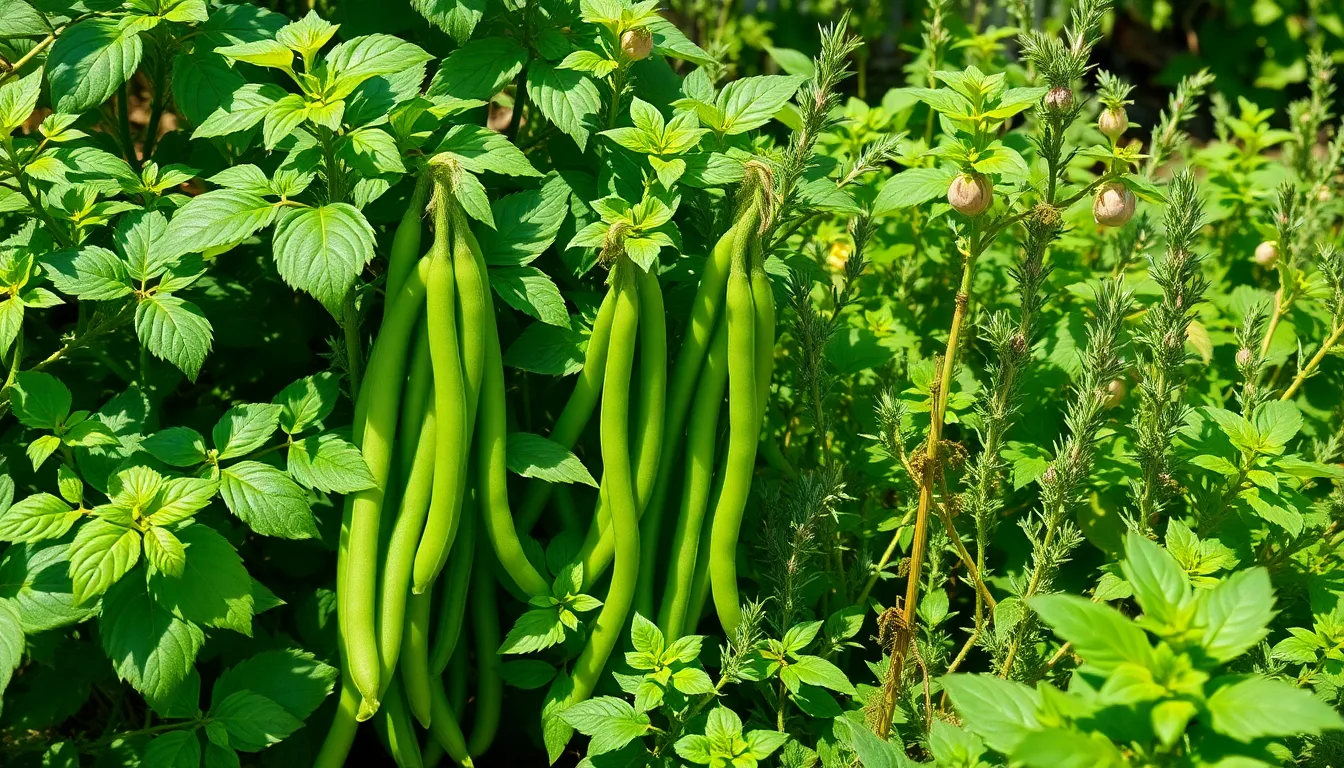
Aromatic herbs offer dual benefits when planted alongside green beans, naturally deterring pests while improving the flavor profile of your harvest. We’ve found these three herbs particularly effective at creating a protective barrier around bean plants.
Basil: Flavor Enhancement and Pest Control
Basil transforms both the taste and health of green bean plants through its powerful aromatic compounds. We recommend planting basil within 12 inches of your bean rows to maximize its pest-repelling effects against aphids, bean beetles, and thrips.
Growing basil near green beans improves the beans’ natural sweetness while the herb’s strong fragrance creates an invisible shield against harmful insects. Plant sweet basil varieties like Genovese or Thai basil between bean plants for optimal coverage and flavor enhancement.
Strategic placement matters when combining basil with green beans. Space basil plants 8-10 inches apart to prevent overcrowding while ensuring adequate pest protection coverage throughout your bean patch.
Oregano: Natural Insect Repellent
Oregano’s potent essential oils repel bean flies, aphids, carrot flies, and moths that commonly target green bean crops. We’ve observed important pest reduction when oregano borders surround bean plantings, creating a natural barrier against these destructive insects.
Antimicrobial properties in oregano reduce fungal diseases that often affect bean plants in humid conditions. Plant Greek oregano or Italian oregano varieties near your beans to take advantage of these protective compounds.
Flowering oregano attracts beneficial insects like ladybugs and parasitic wasps that prey on bean pests. Allow some oregano plants to bloom throughout the growing season to maintain this beneficial insect population in your garden.
Rosemary: Aromatic Protection
Rosemary’s woody stems and needle-like leaves emit oils that deter bean weevils and cucumber beetles. We position rosemary plants at the corners of bean beds to create protective zones without competing for root space.
Perennial rosemary provides year-round pest protection once established, making it an excellent long-term companion for annual bean plantings. Choose compact varieties like ‘Spice Islands’ or ‘Blue Boy’ that won’t overshadow young bean plants.
Drought-tolerant rosemary thrives in well-draining soil similar to what green beans prefer, making them compatible growing partners. Plant rosemary 18-24 inches from bean rows to prevent root competition while maintaining pest protection benefits.
Vegetable Partners That Maximize Garden Space
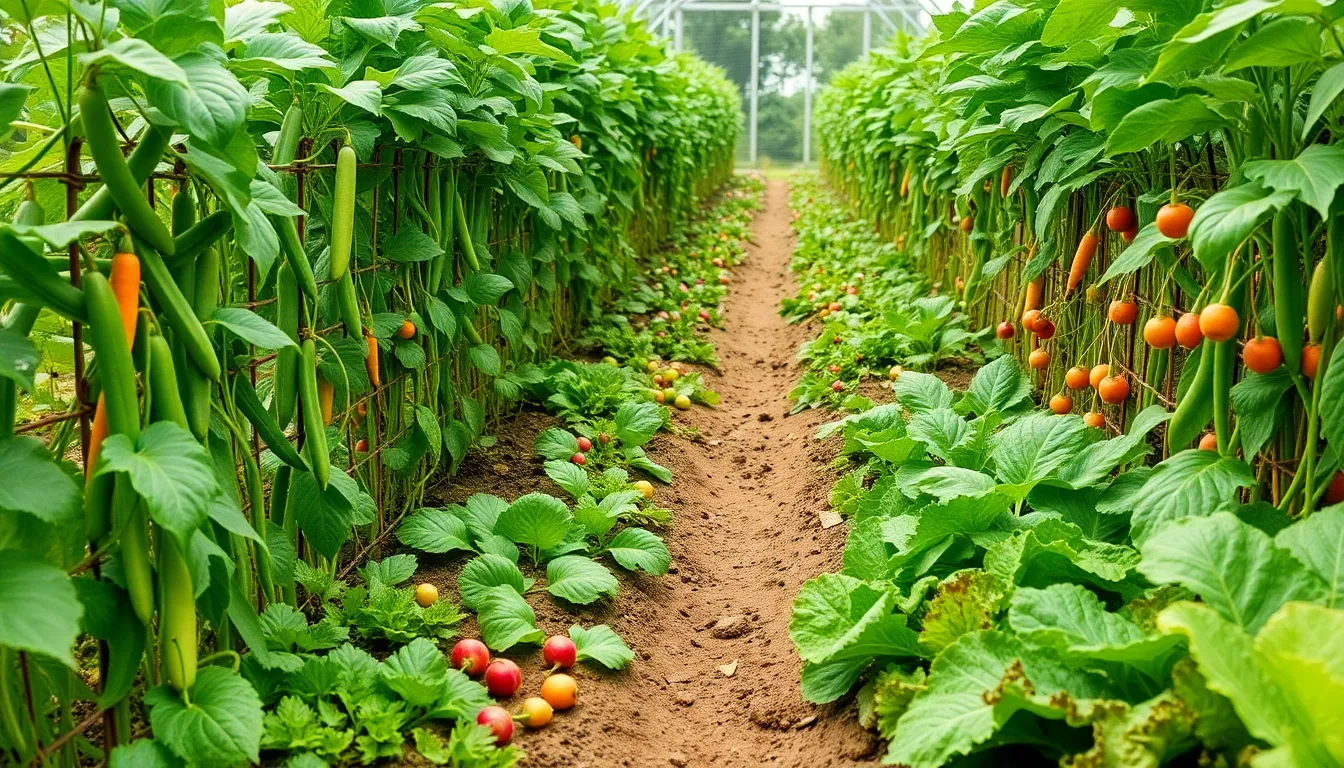
Strategic companion planting with vegetables transforms our green bean garden into a highly efficient growing system. These partnerships optimize every square inch of garden space while providing mutual benefits.
Carrots: Underground Space Utilization
Carrots complement green beans perfectly by utilizing underground space without creating competition. Root vegetables like carrots grow beneath the soil surface while beans develop above ground, allowing us to double our harvest potential in the same garden bed. Research shows that beans fix nitrogen in the soil, which directly benefits root crops like carrots by providing essential nutrients for healthy development.
Planting carrots alongside beans maximizes our garden’s vertical growing potential. Beans capture nitrogen from the air and enrich the soil, creating an ideal growing environment for carrots that need nutrient-rich conditions. We can plant carrot seeds between bean rows, spacing them 2-3 inches apart to avoid any root interference while maintaining optimal growing conditions for both crops.
Radishes: Quick-Growing Soil Aerators
Radishes serve as natural soil aerators that prepare the ground for healthy bean growth. These fast-growing vegetables break up compacted soil with their taproots, creating better drainage and air circulation for bean root systems. Studies indicate that radishes planted before beans can attract beneficial insects and confuse pests that typically target bean plants.
Succession planting radishes throughout the growing season provides continuous soil improvement benefits. Radish flowers attract predatory insects that help control bean pests naturally, reducing our need for chemical interventions. We can harvest radishes in just 25-30 days, making space for additional plantings while maintaining the soil conditioning benefits throughout the bean growing season.
Lettuce: Cool Season Shade Tolerance
Lettuce thrives in the natural shade provided by bean plants, extending our harvest season significantly. Cool-season crops like lettuce benefit from protection against heat and sun exposure, which beans naturally provide as they grow taller. This partnership prevents lettuce from bolting prematurely and maintains tender, flavorful leaves throughout warmer months.
Growing lettuce beneath bean plants creates a living mulch system that conserves soil moisture. Bean canopy coverage protects lettuce from harsh sunlight while the nitrogen fixed by beans enriches the soil for optimal lettuce growth. We can plant lettuce varieties in early spring and continue harvesting fresh greens well into summer when beans provide adequate shade coverage.
Root Vegetables That Improve Soil Structure
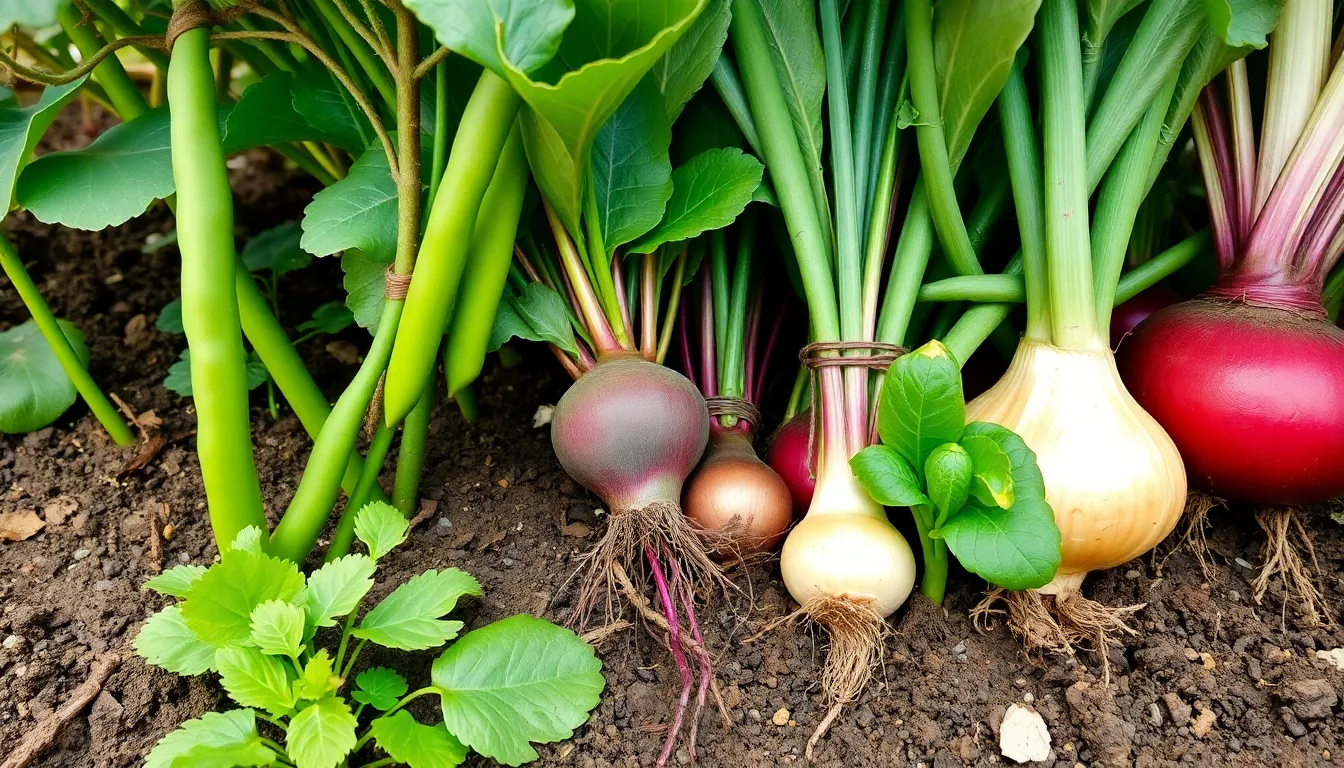
Smart companion planting includes root vegetables that enhance soil conditions for your green beans. These underground allies create better growing environments while complementing your beans’ deep root systems.
Beets: Deep Root Benefits
Beets penetrate deep into the soil profile, creating natural channels that improve aeration and drainage for neighboring green bean plants. Their vigorous root system breaks through compacted layers that shallow roots can’t reach, improving overall soil structure. We’ve found that beets’ deep roots complement green beans’ extensive root networks without creating competition for space or nutrients.
Growing beets alongside your green beans provides dual benefits: improved soil conditions and a continuous harvest of both root vegetables and leafy greens. Plant beets 6-8 inches away from bean rows to give both crops adequate space for root development. The nitrogen that green beans fix enriches the soil for beets, while beet roots create pathways for better water infiltration and air circulation.
Turnips: Natural Soil Breakers
Turnips function as nature’s soil cultivation tools, using their vigorous roots to break up hardpan and compacted earth layers. Their powerful taproot system loosens dense soil areas that can restrict green bean root expansion and water movement. We recommend turnips particularly for gardens with clay soil or areas that haven’t been cultivated recently.
These robust root vegetables create improved soil structure that benefits green beans for seasons to come. Turnips’ aggressive root growth penetrates 12-18 inches deep, opening channels for enhanced nutrient and water access. Plant turnip seeds between green bean rows in late summer for fall harvest, allowing their roots to work the soil during the beans’ peak growing season.
Onions: Pest-Repelling Properties
Onions provide natural pest control that protects green beans from common garden threats like aphids, bean beetles, and thrips. Their sulfur compounds create an aromatic barrier that deters harmful insects while attracting beneficial predators to your garden space. We’ve observed important reductions in pest damage when onions are strategically planted around green bean crops.
Growing onions near green beans creates a protective zone that extends throughout the growing season. Plant onion sets or transplants 4-6 inches from bean plants to maximize their pest-deterrent effects without root interference. The shallow root system of onions complements green beans’ deeper roots, allowing both crops to thrive without competing for soil resources or nutrients.
Flowering Companions That Attract Beneficial Insects
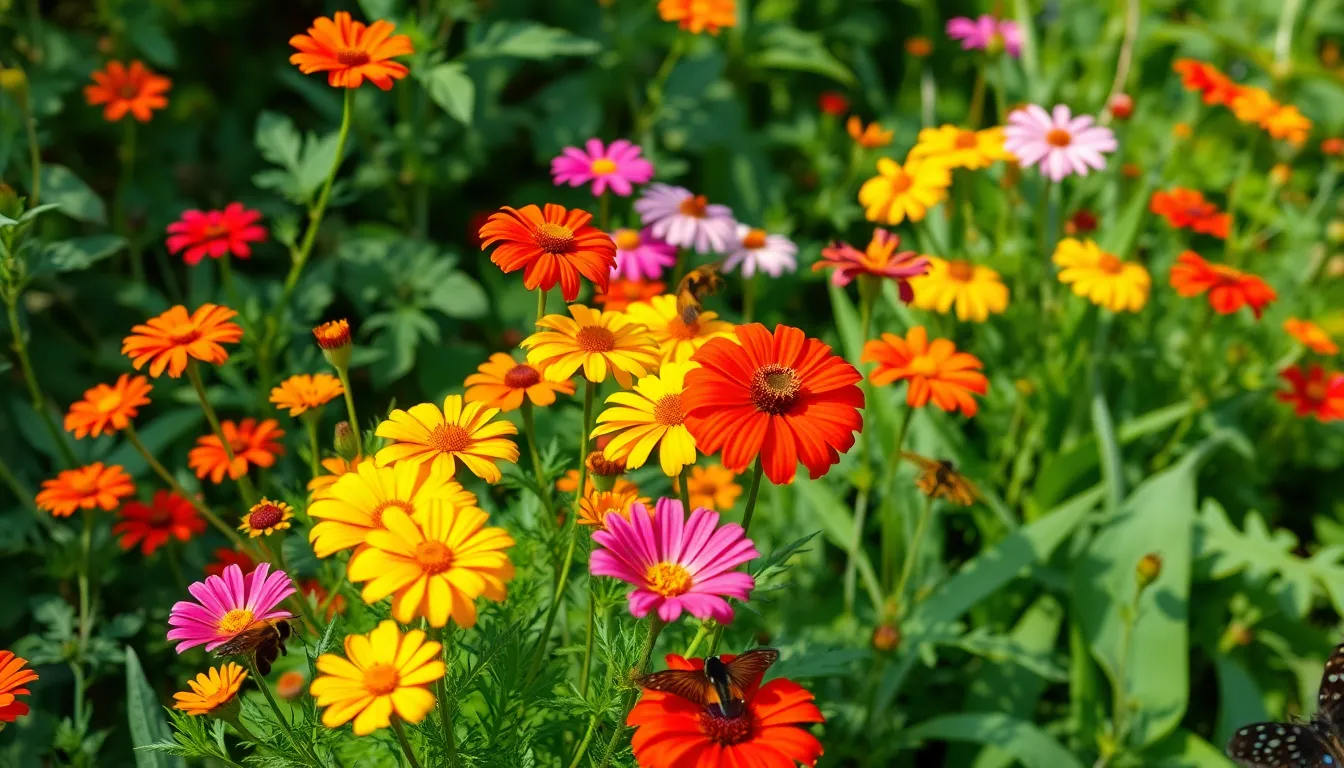
Beneficial insects play a crucial role in green bean success by providing natural pest control and pollination services. Strategic placement of flowering companions creates a thriving network that supports both bean plants and the helpful insects they depend on.
Calendula: Pollinator Magnets
Calendula flowers serve as powerful pollinator magnets that dramatically increase beneficial insect activity around green bean plants. These vibrant orange and yellow blooms attract bees, hoverflies, and parasitic wasps that provide essential pollination services for bean crops. We recommend planting calendula in clusters throughout the bean garden to create consistent nectar sources that keep beneficial insects nearby.
The continuous flowering nature of calendula ensures season-long support for pollinators when green beans need them most. These hardy annuals require minimal care while delivering maximum impact on garden biodiversity. Planting calendula seeds directly around bean rows creates natural pest management zones where beneficial insects can establish breeding populations.
Zinnia: Colorful Garden Additions
Zinnia flowers transform green bean gardens into butterfly havens while providing essential pollinator support throughout the growing season. These colorful garden additions attract butterflies, native bees, and predatory insects that control common bean pests like aphids and spider mites. We suggest choosing tall zinnia varieties that won’t compete with climbing bean plants for vertical space.
The nectar-rich blooms of zinnias create feeding stations that encourage beneficial insects to patrol nearby bean plants for pest control opportunities. These drought-tolerant flowers thrive in similar growing conditions as green beans, making them ideal garden companions. Planting zinnias along garden borders establishes protective zones where beneficial insects can overwinter and multiply.
Cosmos: Low-Maintenance Beauty
Cosmos flowers offer the perfect low-maintenance solution for attracting pollinators to green bean gardens without demanding extensive care or resources. These delicate blooms create landing platforms for beneficial insects while contributing to healthy garden ecosystems around bean plants. We recommend cosmos for their ability to self-seed and return year after year with minimal intervention.
The open flower structure of cosmos provides easy access for small beneficial insects like ladybugs and lacewings that prey on bean pests. These adaptable flowers tolerate poor soil conditions and actually produce more blooms when grown in lean soils similar to bean preferences. Cosmos planted in drifts throughout the bean garden create corridors that beneficial insects use to move between different areas of pest control activity.
Plants to Avoid Near Green Bean Companion Plants
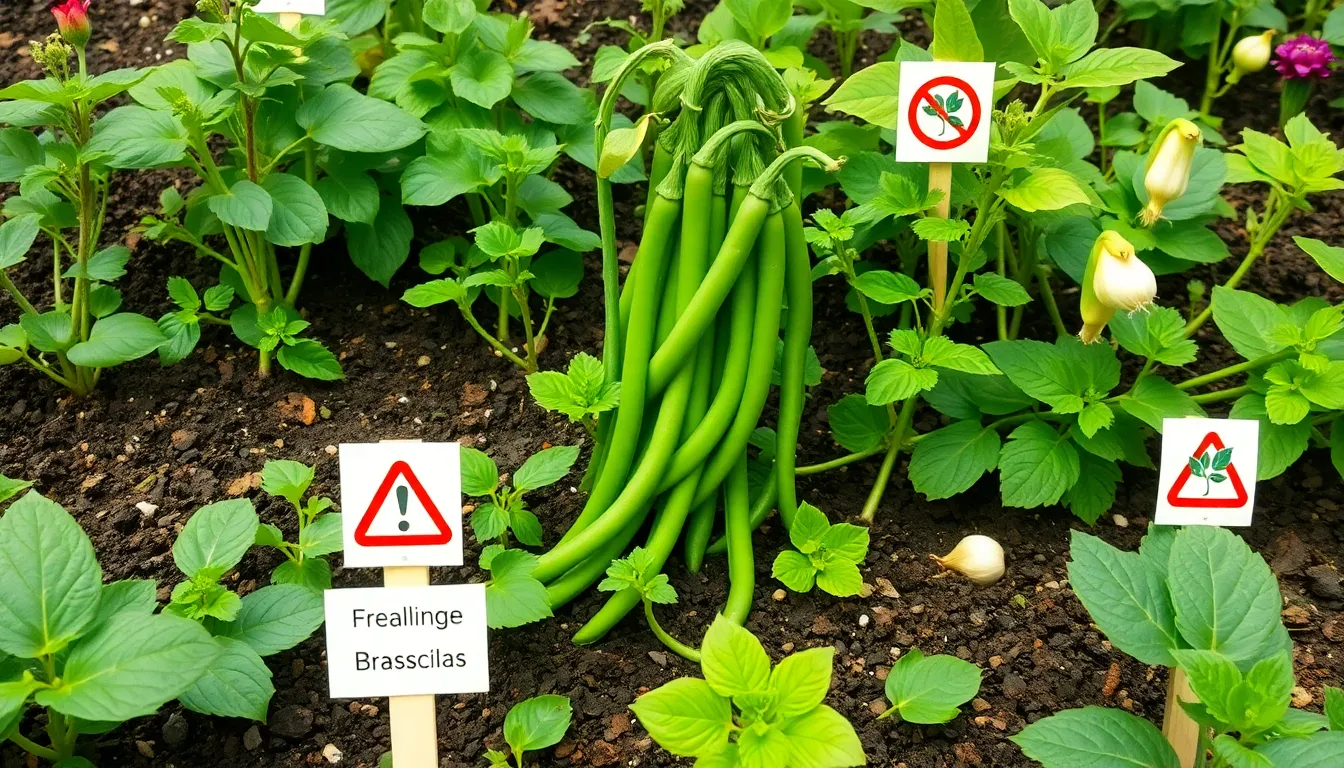
While we’ve explored beneficial companions for our green beans, certain plants can actually hinder their growth and productivity. Understanding which plants to avoid helps us create the most successful garden layout possible.
Fennel: Allelopathic Interference
Fennel releases natural chemicals into the soil that actively inhibit green bean growth through a process called allelopathy. These chemical compounds interfere with our beans’ ability to absorb nutrients and develop properly. We should plant fennel in a completely separate area of our garden, at least 10 feet away from any bean crops. The allelopathic effects can persist in the soil even after fennel is removed, making crop rotation planning essential. Consider dedicating a exact herb section for fennel where it won’t impact our vegetable production.
Onion Family Members: Growth Inhibition
Onions, leeks, garlic, and scallions kill the beneficial nitrogen-fixing bacteria that live on green bean roots. Without these essential bacteria, our beans lose their natural ability to convert atmospheric nitrogen into usable plant nutrients. This disruption reduces the nitrogen availability that beans depend on for healthy growth and pod development. We’ll notice stunted plants and reduced yields when onion family members grow too close to our bean crops. Plant these alliums at least 3 feet away from bean rows to prevent bacterial interference while still enjoying their pest-repelling benefits elsewhere in the garden.
Brassicas: Nutrient Competition
Cabbage, broccoli, cauliflower, and other brassica family plants compete directly with green beans for the same soil nutrients. Both plant families require similar nitrogen, phosphorus, and potassium levels, creating intense competition in the root zone. Our beans may show signs of nutrient deficiency including yellowing leaves and poor pod formation when grown near brassicas. The competition becomes especially problematic in smaller garden spaces where root systems overlap significantly. We can successfully grow both plant types by spacing them at least 4 feet apart or planting them in different garden beds entirely.
Conclusion
We’ve covered a comprehensive range of companion plants that can transform your green bean garden into a thriving network. From the classic corn partnership to aromatic herbs and beneficial flowers each companion serves a exact purpose in creating optimal growing conditions.
Remember that successful companion planting isn’t just about what you plant together—it’s equally important to understand what plants to keep separate. The spacing guidelines and timing tips we’ve shared will help you avoid common mistakes that could hinder your harvest.
By implementing these proven companion planting strategies you’ll create a more resilient garden that naturally manages pests attracts beneficial insects and maximizes your available space. Your green beans will thank you with healthier growth and more abundant yields season after season.
Frequently Asked Questions
What is companion planting for green beans?
Companion planting for green beans involves strategically pairing them with other plants that enhance soil health, deter pests, and increase harvest potential. This gardening technique creates beneficial partnerships where plants support each other’s growth, leading to healthier crops and improved garden productivity through natural methods.
Which plants make the best companions for green beans?
The best companions for green beans include corn (provides vertical support), marigolds (natural pest deterrent), sunflowers (sturdy support for pole beans), basil (repels harmful insects), and carrots (utilize underground space efficiently). These plants create synergistic relationships that benefit both crops without competing for resources.
Can I plant peas and green beans together?
Yes, you can plant peas and green beans together effectively. Peas can increase soil nitrogen availability by up to 40% and improve soil aeration. Plant peas in early spring, spacing them 4-6 inches from bean rows to avoid root competition while maximizing their nitrogen-fixing benefits.
What plants should I avoid planting near green beans?
Avoid planting fennel (releases growth-inhibiting chemicals), onion family members like garlic and leeks (kill beneficial nitrogen-fixing bacteria), and brassicas like cabbage and broccoli (compete for nutrients) near green beans. Maintain distances of 3-10 feet depending on the plant to prevent interference.
How do marigolds help green beans?
Marigolds act as natural pest deterrents for green beans by releasing compounds that repel harmful insects like aphids, bean beetles, and nematodes. They significantly reduce pest damage while adding vibrant color to the garden, making them both functional and decorative companion plants.
What herbs work well with green beans?
Basil, oregano, and rosemary are excellent herb companions for green beans. Basil repels aphids and bean beetles while enhancing bean sweetness. Oregano deters pests and attracts beneficial insects. Rosemary effectively protects against bean weevils and cucumber beetles while requiring minimal garden space.
Can I grow lettuce with green beans?
Yes, lettuce thrives as a companion to green beans. It grows well in the shade provided by bean plants, extends the harvest season, and helps conserve soil moisture. This pairing maximizes garden space efficiency while both crops benefit from the partnership without competing for resources.
How do root vegetables benefit green beans?
Root vegetables like carrots, beets, and radishes improve soil structure for green beans. Carrots utilize underground space without competition, beets enhance soil aeration and drainage with deep roots, and radishes break up compacted soil while attracting beneficial insects to the garden ecosystem.
What flowers attract beneficial insects to green bean plants?
Calendula, zinnias, and cosmos are excellent flowering companions that attract beneficial insects to green bean gardens. These flowers draw pollinators, predatory insects, and other beneficial creatures that provide natural pest control and support healthy garden ecosystems around your bean plants.
When should I plant companion plants with green beans?
Plant timing varies by companion: start peas in early spring before beans, plant warm-season companions like basil and marigolds alongside beans after frost danger passes, and sow quick-growing crops like radishes throughout the season. Consider each plant’s specific growing requirements for optimal companion benefits.







